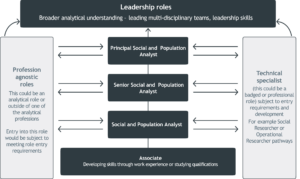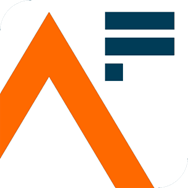Role profile: social and population analyst
Social and population analysts specialise in using primary and secondary source data to understand the story that the data tells. They also use primary and secondary source data to give detail and answer questions on aspects of society. They use this information to give briefings to lots of different audiences.
Social and population analysts have quantitative and qualitative analytical skills. They have experience of working in an analytical role. They may have worked as Research Officers, or be members of the Government Social Research (GSR) profession. Social and population analysts often work in multi-disciplinary teams.
Typical role responsibilities
Social and population analysts:
- use analysis to inform outcomes and priorities – they do this by helping develop the analysis of data from diverse sources and interpreting outputs for a range of different stakeholders
- work on a variety of research projects and use a range of research methodologies
- commission, design, and manage analysis
- identify suitable data sources
- create analytical frameworks
- interpret and communicate results of analysis
Skills
There are several important skills that social and population analysts need to be successful in their role.
Find out more about skill level definitions.
You must have knowledge of quantitative and qualitative research methods. You must also understand how to use these methods in research projects.
You will be expected to demonstrate these skills at different levels depending on the seniority of your role.
Associate social and population analyst
As an associate social and population analyst, you must have an ‘awareness’ skill level.
Social and population analyst
As a social and population analyst, you must have a ‘practitioner’ skill level.
Senior social and population analyst
As a senior social and population analyst, you must have an ‘expert’ skill level.
Principal social and population analyst
As a principal social and population analyst, you must have an ‘expert’ skill level.
You must have social and population, quantitative and qualitative analytical skills. This includes knowledge of specialist techniques, such as standardisation and statistical process control. You must be able to work with a range of data sources.
You will be expected to demonstrate these skills at different levels depending on the seniority of your role.
Associate social and population analyst
As an associate social and population analyst, you must have an ‘awareness’ skill level.
Social and population analyst
As a social and population analyst, you must have a ‘practitioner’ skill level.
Senior social and population analyst
As a senior social and population analyst, you must have an ‘expert’ skill level.
Principal social and population analyst
As a principal social and population analyst, you must have an ‘expert’ skill level.
You must have strong verbal and written communication skills. These skills will enable you to share insights with stakeholders.
You will be expected to demonstrate these skills at different levels depending on the seniority of your role.
Associate social and population analyst
As an associate social and population analyst, you must have an ‘awareness’ skill level.
Social and population analyst
As a social and population analyst, you must have a ‘practitioner’ skill level.
Senior social and population analyst
As a senior social and population analyst, you must have an ‘expert’ skill level.
Principal social and population analyst
As a principal social and population analyst, you must have an ‘expert’ skill level.
You must be able to interpret requirements and present data in a clear and compelling way, using graphical representations and data visualisations.
You will be expected to demonstrate these skills at different levels depending on the seniority of your role.
Associate social and population analyst
As an associate social and population analyst, you must have an ‘awareness’ skill level.
Social and population analyst
As a social and population analyst, you must have a ‘practitioner’ skill level.
Senior social and population analyst
As a senior social and population analyst, you must have an ‘expert’ skill level.
Principal social and population analyst
As a principal social and population analyst, you must have an ‘expert’ skill level.
You must be able to:
- make use of different sources of information
- analyse important data sets and interpret your findings
- use computer software to analyse and present information
- demonstrate knowledge of relevant data analysis packages
- accurately interpret data and research papers
You will be expected to demonstrate these skills at different levels depending on the seniority of your role.
Associate social and population analyst
As an associate social and population analyst, you must have an ‘awareness’ skill level.
Social and population analyst
As a social and population analyst, you must have a ‘practitioner’ skill level.
Senior social and population analyst
As a senior social and population analyst, you must have an ‘expert’ skill level.
Principal social and population analyst
As a principal social and population analyst, you must have an ‘expert’ skill level.
You must have knowledge of the quality assurance methodologies needed for analytical work. You must understand the context and relevance of quality assurance products, such as the Aqua Book.
You will be expected to demonstrate these skills at different levels depending on the seniority of your role.
Associate social and population analyst
As an associate social and population analyst, you must have an ‘awareness’ skill level.
Social and population analyst
As a social and population analyst, you must have a ‘practitioner’ skill level.
Senior social and population analyst
As a senior social and population analyst, you must have an ‘expert’ skill level.
Principal social and population analyst
As a principal social and population analyst, you must have an ‘expert’ skill level.
Sample career pathway
The social and population analyst career path shows some of the common entry and exit points for the role. It also shows the typical skill levels needed.
You can enter a social and population analyst role from another analytical profession or other professions, such as the policy profession. You can also exit the role to join another profession.

The diagram shows a potential career path. It shows that you can enter or leave a role from a wide range of backgrounds and experience levels. For example, you could become a social and population analyst by developing your skills in an associate role. You could continue to move up the levels in the career path by taking on more senior social and population analyst roles. Or you could develop your skills by working in a technical specialist role in an analytical or digital profession. You could also develop the necessary skills by working in a profession agnostic role outside of these professions.
A role that could be done by any person with the relevant skills or experience from any profession.
This could be a ‘badged’ or professional role that is subject to entry requirements and development.
Beyond the principal social and population analyst role, you could go into more senior leadership roles. These roles require broader analytical understanding, and the ability to lead multi-disciplinary teams.
